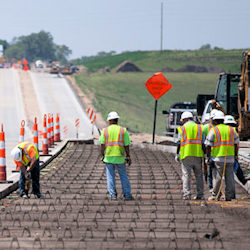Work Zone Best Practices
Employers
Employers should conduct crew meetings and train all workers on work zone safety. They should discuss important safety topics including: potential hazards, equipment blind spots, and movement precautions in the activity area.
Employers should also have the following to protect workers in a work zone:
- a comprehensive site-specific safety program; and
- a Temporary Traffic Control Plan (TTCP) in place for the project site.
Workers
Workers should do the following in and around the work zone:
- Wear high-visibility safety apparel (vest and head gear).
- Be alert for construction vehicles, equipment, and general traffic.
- Check surroundings often for hazards.
- Know the plan for traffic flow.
- Keep a safe distance from traffic.
- Communicate with other workers, especially when there are changes in procedures, locations, or traffic flow pattern.
- Stay behind the protective barriers.
- If you do not have a reason for being there, do not linger or cross into areas around moving equipment.
- Use extra precautions and additional safety apparel at night and during poor weather conditions.
- Reduce spacing between channelizing devices (discussed in Module 3) at night to compensate for reduced driver visibility.
- Ensure the light levels of arrow panels are set at nighttime levels; daytime settings used at night produce blinding light.
- Increase the size of traffic control devices, reflective material, and lettering to improve driver recognition at night.
- Keep operators who are working near moving equipment in eye contact.
- Remember equipment blind spots and limited visual areas.
Equipment/Vehicle Operators
- Keep windows and mirrors clean.
- Watch for workers on foot and know where they are located.
- Remember equipment blind spots and limited visual areas.
Knowledge Check Choose the best answer for the question.
1-4. What should be done to improve driver recognition of directions when traveling through a work zone at night?
You forgot to answer the question!

